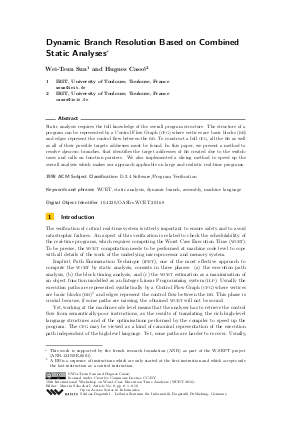Dynamic Branch Resolution Based on Combined Static Analyses
Authors Wei-Tsun Sun, Hugues Cassé
-
Part of:
Volume:
16th International Workshop on Worst-Case Execution Time Analysis (WCET 2016)
Part of: Series: Open Access Series in Informatics (OASIcs)
Part of: Conference: Workshop on Worst-Case Execution Time Analysis (WCET) - License:
 Creative Commons Attribution 3.0 Unported license
Creative Commons Attribution 3.0 Unported license
- Publication Date: 2016-12-20
File

PDF
OASIcs.WCET.2016.8.pdf
- Filesize: 0.5 MB
- 10 pages
Document Identifiers
Subject Classification
Keywords
- WCET
- static analysis
- dynamic branch
- assembly
- machine language
Metrics
- Access Statistics
-
Total Accesses (updated on a weekly basis)
0PDF Downloads0Metadata Views
Abstract
Static analysis requires the full knowledge of the overall program structure. The structure of a program can be represented by a Control Flow Graph (CFG) where vertices are basic blocks (BB) and edges represent the control flow between the BB. To construct a full CFG, all the BB as well as all of their possible targets addresses must be found. In this paper, we present a method to resolve dynamic branches, that identifies the target addresses of BB created due to the switch-cases and calls on function pointers. We also implemented a slicing method to speed up the overall analysis which makes our approach applicable on large and realistic real-time programs.
Cite As Get BibTex
Wei-Tsun Sun and Hugues Cassé. Dynamic Branch Resolution Based on Combined Static Analyses. In 16th International Workshop on Worst-Case Execution Time Analysis (WCET 2016). Open Access Series in Informatics (OASIcs), Volume 55, pp. 8:1-8:10, Schloss Dagstuhl – Leibniz-Zentrum für Informatik (2016)
https://doi.org/10.4230/OASIcs.WCET.2016.8
BibTex
@InProceedings{sun_et_al:OASIcs.WCET.2016.8,
author = {Sun, Wei-Tsun and Cass\'{e}, Hugues},
title = {{Dynamic Branch Resolution Based on Combined Static Analyses}},
booktitle = {16th International Workshop on Worst-Case Execution Time Analysis (WCET 2016)},
pages = {8:1--8:10},
series = {Open Access Series in Informatics (OASIcs)},
ISBN = {978-3-95977-025-5},
ISSN = {2190-6807},
year = {2016},
volume = {55},
editor = {Schoeberl, Martin},
publisher = {Schloss Dagstuhl -- Leibniz-Zentrum f{\"u}r Informatik},
address = {Dagstuhl, Germany},
URL = {https://drops.dagstuhl.de/entities/document/10.4230/OASIcs.WCET.2016.8},
URN = {urn:nbn:de:0030-drops-69014},
doi = {10.4230/OASIcs.WCET.2016.8},
annote = {Keywords: WCET, static analysis, dynamic branch, assembly, machine language}
}
Author Details
References
-
G. Balakrishnan, R. Gruian, T. Reps, and T. Teitelbaum. Compiler Construction: 14th International Conference, CC 2005, chapter CodeSurfer/x86 - A Platform for Analyzing x86 Executables, pages 250-254. Springer Berlin, 2005.

-
G. Balakrishnan and T. Reps. Analyzing memory accesses in x86 executables. In Compiler Construction, volume 2985 of Lecture Notes in Computer Science, pages 2732-2733. Springer Berlin, 2004.

-
G. Balakrishnan, T. Reps, D. Melski, and T. Teitelbaum. Verified Software: Theories, Tools, Experiments, chapter WYSINWYX: What You See Is Not What You eXecute, pages 202-213. Springer Berlin Heidelberg, 2008.

-
S. Bardin, P. Herrmann, and F. Védrine. Refinement-based CFG reconstruction from unstructured programs, pages 54-69. Springer, 2011.

- Hugues Cassé, Florian Birée, and Pascal Sainrat. Multi-architecture value analysis for machine code. In 13th International Workshop on Worst-Case Execution Time Analysis, WCET 2013, July 9, 2013, Paris, France, pages 42-52, 2013. URL: http://dx.doi.org/10.4230/OASIcs.WCET.2013.42.
-
P. Cousot and R. Cousot. Abstract interpretation: a unified lattice model for static analysis of programs by construction or approximation of fixpoints. In Conference Record of the Fourth Annual ACM SIGPLAN-SIGACT, pages 238-252. ACM Press, 1977.

- Niklas Holsti, Jan Gustafsson, Linus Källberg, and Björn Lisper. Analysing switch-case code with abstract execution. In 15th International Workshop on Worst-Case Execution Time Analysis, WCET 2015, July 7, 2015, Lund, Sweden, pages 85-94, 2015. URL: http://dx.doi.org/10.4230/OASIcs.WCET.2015.85.
-
S. S. Muchnick. Advanced Compiler Design &Implementation. Morgan Kaufmann, 1997.

- WCET Project Mälardalen University. Benchmarks. URL: http://www.mrtc.mdh.se/projects/wcet/benchmarks.html.
-
C. Sandberg, A. Ermedahl, J. Gustafsson, and B. Lisper. Faster WCET Flow Analysis by Program Slicing. In Proceedings of the 2006 ACM SIGPLAN/SIGBED, pages 103-112. ACM, 2006.

-
R. Sen and Y. N. Srikant. Executable Analysis with Circular Linear Progressions. Technical Report IISc-CSA-TR-2007-3, Computer Science and Automation Indian Institute of Science, February 2007.

-
A. Silberschatz, P. B. Galvin, and G. Gagne. Operating system concepts, volume 4. Addison-Wesley Reading, 1998.

-
H. Theiling. Extracting safe and precise control flow from binaries. In Proc. of 7th Conference on Real-Time Computing System and Applications, 2000.

-
M. Weiser. Program slicing. In Proceedings of the 5th International Conference on Software Engineering, pages 439-449. IEEE Press, 1981.

-
W. Yin, L. Jiang, Q. Yin, L. Zhou, and J. Li. A control flow graph reconstruction method from binaries based on XML. In Computer Science-Technology and Applications, 2009. IFCSTA'09. International Forum on, volume 2, pages 226-229, Dec 2009.

